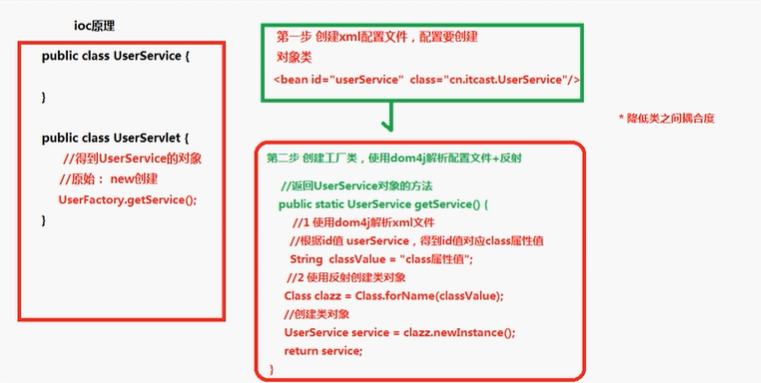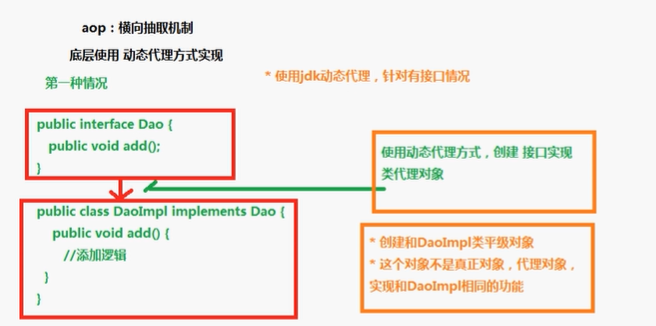摘自:https://www.cnblogs.com/ljw1994/p/11820321.html
概述
- 下载地址:https://repo.spring.io/release/org/springframework/spring/
- spring是开源的轻量级框架
- spring核心的主要两部分
- AOP :面向切面编程,扩展功能而不修改源代码
- IOC :控制反转,对象的创建通过spring配置来实现
- spring是一站式框架
- web :springMVC
- service :IOC
- dao :JDBC
IOC
IOC的底层原理
- 创建xml配置文件,配置要创建对象的类
<bean id="userSevice" class="com.ljw.service.UserService"> - bean标签的属性
- id:值不能有特殊字符
- class:要配置的类的路径
- scope:创建对象的方式
- singleton:默认值,单例
- prototype:多例
- name:跟id类似,但可以有特殊字符
- applicationContext.xml的默认内容
<?xml version="1.0" encoding="UTF-8"?>
<beans
xmlns="http://www.springframework.org/schema/beans"
xmlns:xsi="http://www.w3.org/2001/XMLSchema-instance"
xmlns:context="http://www.springframework.org/schema/context"
xmlns:jdbc="http://www.springframework.org/schema/jdbc"
xmlns:jee="http://www.springframework.org/schema/jee"
xmlns:tx="http://www.springframework.org/schema/tx"
xmlns:aop="http://www.springframework.org/schema/aop"
xmlns:mvc="http://www.springframework.org/schema/mvc"
xmlns:util="http://www.springframework.org/schema/util"
xmlns:jpa="http://www.springframework.org/schema/data/jpa"
xsi:schemaLocation="
http://www.springframework.org/schema/beans http://www.springframework.org/schema/beans/spring-beans-4.1.xsd
http://www.springframework.org/schema/context http://www.springframework.org/schema/context/spring-context-4.1.xsd
http://www.springframework.org/schema/jdbc http://www.springframework.org/schema/jdbc/spring-jdbc-4.1.xsd
http://www.springframework.org/schema/jee http://www.springframework.org/schema/jee/spring-jee-4.1.xsd
http://www.springframework.org/schema/tx http://www.springframework.org/schema/tx/spring-tx-4.1.xsd
http://www.springframework.org/schema/data/jpa http://www.springframework.org/schema/data/jpa/spring-jpa-1.3.xsd
http://www.springframework.org/schema/aop http://www.springframework.org/schema/aop/spring-aop-4.1.xsd
http://www.springframework.org/schema/mvc http://www.springframework.org/schema/mvc/spring-mvc-4.1.xsd
http://www.springframework.org/schema/util http://www.springframework.org/schema/util/spring-util-4.1.xsd">
</beans>- 创建工厂类,使用dom4j解析xml配置文件+反射,得到该类的实例

属性注入(DI)
- DI:依赖注入,向类里面的属性设置值
- set方法
- 在类中定义该属性的set方法
- 在
spring_context.xml配置文件中配置相关的设置
- 有参构造
- 定义有参构造方法
- 在
spring_context.xml配置文件中配置相关的设置
- 对象属性注入
- 将要注入对象设置为类的属性
- 在
spring_context.xml配置文件中配置相关的设置
spring_context.xml中的配置:
测试:
- 复杂类型的注入
- Array
- List
- Map
- properties

Spring 的 bean 管理(注解)
-
注解详情请查看文章:注解 @Annotation
一、导入 jar 包

二、创建 Spring 配置文件,导入约束
<?xml version="1.0" encoding="UTF-8"?>
<beans xmlns="http://www.springframework.org/schema/beans"
xmlns:xsi="http://www.w3.org/2001/XMLSchema-instance"
xmlns:context="http://www.springframework.org/schema/context" xsi:schemaLocation="
http://www.springframework.org/schema/beans http://www.springframework.org/schema/beans/spring-beans.xsd
http://www.springframework.org/schema/context http://www.springframework.org/schema/context/spring-context.xsd"> <!-- bean definitions here -->
</beans>三、再 Spring 中开启注解扫描

- 如果有多个包,就填写共有的包名
四、注解创建对象

4.1 创建对象有四个注解
- @Component
- @Controller
- @Service
- @Repository
- 目前这四个注解的功能是一致的,都是创建对象,只是为了让标注类本身的用途清晰
4.2 创建对象的方式
@Scope(value="singleton")单实例@Scope(value="prototype")多实例
五、注解注入属性
- 创建service类,创建dao类,再service中得到dao对象
-
用注解创建 dao 对象和 service 对象


-
再service类中创建dao类型的属性,并用注解注入对象,有两种方式
第一种:@Autowired
第二种:@Resource

- 测试
-
-
AOP
一、AOP概念
- AOP:面向切面(方面)编程
- AOP采取横向抽取机制,取代了传统纵向继承体系重复性代码
二、AOP原理

三、AOP操作术语
- Joinpoint(连接点): 类里面可以被增强的方法,这些方法称为连接点(可以被增强的方法)
- Pointcut(切入点):所谓切入点是指我们要对哪些Joinpoint进行拦截的定义.
- Advice(通知/增强):所谓通知是指拦截到Joinpoint之后所要做的事情就是通知.通知分为前置通知,后置通知,异常通知,最终通知,环绕通知(切面要完成的功能,在方法之前和之后执行(比如:计算程序运行的时间))
- Aspect(切面): 是切入点和通知(引介)的结合
- Introduction(引介):引介是一种特殊的通知在不修改类代码的前提下, - Introduction可以在运行期为类动态地添加一些方法或Field.
- Target(目标对象):代理的目标对象(要增强的类)
- Weaving(织入):是把增强应用到目标的过程.
- 把advice 应用到 target的过程
- Proxy(代理):一个类被AOP织入增强后,就产生一个结果代理类
四、使用AspectJ实现AOP
1. 介绍
- AspectJ不是Spring的一部分,是和Spring一起使用进行AOP操作
2. 实现AOP的两种方式
- 基于AspectJ的XML配置
- 基于AspectJ的注解方式
3. 实现步骤
- AOP操作准备
-
导入基本jar包和AOP相关的jar包

- 导入AOP约束
<?xml version="1.0" encoding="UTF-8"?> <beans xmlns="http://www.springframework.org/schema/beans" xmlns:xsi="http://www.w3.org/2001/XMLSchema-instance" xmlns:aop="http://www.springframework.org/schema/aop" xsi:schemaLocation=" http://www.springframework.org/schema/beans http://www.springframework.org/schema/beans/spring-beans.xsd http://www.springframework.org/schema/aop http://www.springframework.org/schema/aop/spring-aop.xsd"> <!-- bean definitions here --> </beans> -
- 使用表达式配置切入点
- 切入点:实际增强的方法
- 常用的表达式:execution 表达式
- 增强类
package com.ljw.spring.annotation;
import org.aspectj.lang.ProceedingJoinPoint;
import org.springframework.stereotype.Component;
@Component(value="userAdvice")
public class UserAdvice {
/**
* @description 前置通知
*/
public void userBefore() {
System.out.println("前置通知........");
}
/**
* @description 后置通知
*/
public void userAfter() {
System.out.println("后置通知........");
}
/**
* @description 环绕通知
* @param proceedingJoinPoint
* @throws Throwable
*/
public void userAround(ProceedingJoinPoint proceedingJoinPoint) throws Throwable {
// 方法之前
System.out.println("方法之前..........");
// 执行增强的方法
proceedingJoinPoint.proceed();
// 方法之后
System.out.println("方法之后..........");
}
}
- 配置Spring配置文件
- 导入约束
-
- 配置AOP操作
-
Spring整合web项目
一、实现原理
- 通过 new 对象,功能可以实现,但效率很低
-
实现思想:把加载配置文件和创建对象过程,在服务器启动的时候完成
- 具体实现原理 (1) ServletContext对象 (2) 监听器 (3) 具体步骤
- 在服务器启动的时候,为每个项目创建一个ServletContext对象
- 在 ServletContext 对象创建的时候,使用监听器可以监听 ServletContext对象什么时候创建
- 当监听器监听到 ServletContext 对象创建的时候,加载 spring 配置文件,创建配置文件对象
- 把创建出来的对象放到 ServletContext 域对象里面(setAttribute 方法)
- 获取对象(getAttribute 方法)
知识点
ServletContext 对象
一、介绍
- ServletContext官方叫servlet上下文。服务器会为每一个工程创建一个对象,这个对象就是ServletContext对象
- 这个对象全局唯一,而且工程内部的所有servlet都共享这个对象。所以叫全局应用程序共享对象。
二、作用
- 是一个域对象
- 可以读取全局配置参数
- 可以搜索当前工程目录下面的资源文件
- 可以获取当前工程名字(了解)
三、域对象
- 域对象介绍
- 域对象是服务器在内存上创建的存储空间,用于在不同动态资源(servlet)之间传递与共享数据。
- 怎样得到 ServletContext 对象
ServletContext servletContext = config.getServletContext();ServletContext servletContext = this.getServletContext();
- 域对象方法
- 凡是域对象都有如下三个方法
-
监听器 Listener
一、监听器模型
- 事件:用户对组件的一个操作,或者说程序执行某个方法,称之为一个事件,如机器人程序执行工作。
- 事件源:发生事件的组件就是事件源,也就是被监听的对象,如机器人可以工作,可以跳舞,那么就可以把机器人看做是一个事件源。
- 事件监听器(处理器):监听并负责处理事件的方法,如监听机器人工作情况,在机器人工作前后做出相应的动作,或者获取机器人的状态信息。
二、执行步骤
- 给事件源注册监听器。
- 组件接受外部作用,也就是事件被触发。
- 组件产生一个相应的事件对象,并把此对象传递给与之关联的事件处理器。
- 事件处理器启动,并执行相关的代码来处理该事件。
execution表达式
一、语法
execution(<访问修饰符>?<返回类型><方法全名>(<参数>)<异常>)
二、常用的写法
execution(* com.ljw.spring.aop.User.add(..))对User类的add方法增强execution(* com.ljw.spring.aop.User.*(..))对User类的所有方法增强execution(* *.*(..))对所有方法增强execution(* save*(..))对所有save开头的方法增强




